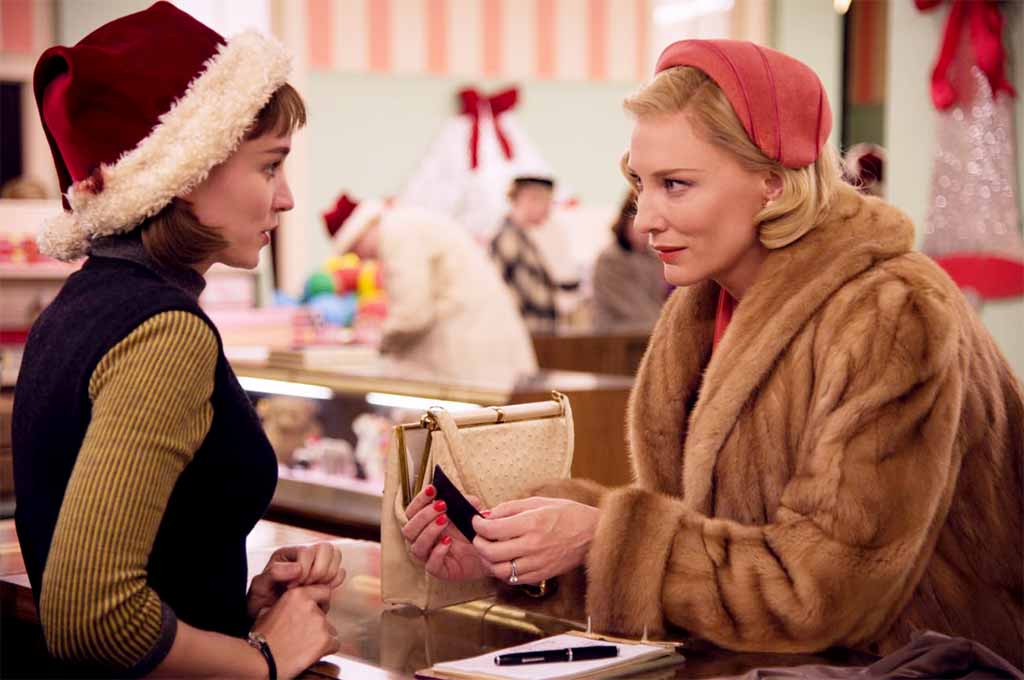Movie review: Carol
Todd Haynes creates a modern masterpiece that speaks directly to the female experience without words thanks to the silent chemistry between stars Cate Blanchett and Rooney Mara
Carol
5/5
Starring: Cate Blanchett, Rooney Mara, Jake Lacy, Sarah Paulson, Kyle Chandler
Directed by: Todd Haynes
Running time: 118 minutes
MPAA Rating: Restricted
By Katherine Monk
It’s all about a mood – a feeling that leaves you aching to knead the unspoken into a satisfying loaf of thought, but sits unleavened like a cold lump of dough at the bottom of your gut.
And so, it’s also about acceptance, and sitting with the choking silence of all the thoughts that cannot be expressed, while pretending to breathe the air of everydayness.
Oh. It’s the stuff of soapy opera and pen nibs dipped in the inkwell of loneliness to scrawl sentences that contain ‘Alas!’ But dissected in the narrative lab of Patricia Highsmith’s prose and processed by the poetic eye of filmmaker Todd Haynes, lesbian melodrama never looked so classy, or so emotionally accurate.
Carol is a masterpiece of modern cinema, a shining reflection of everything movies do well, created in a way that pays homage to the medium itself.
Shot on Arriflex cameras using Super 16mm film stock, Haynes takes us right back to the era by giving us back the shimmering silver grain that digital so clinically removed. It’s not something you really notice because the focus is so crisp and the frames are so composed, but it sneaks up on you in the shadows, where dark green and burgundy blobs weave through the blackness.
It’s these random refractions of light bouncing off and through the emulsion that make a film image unique, and perhaps even more human, as it reflects a certain aspect of life itself in the random chemical reactions that affect our reality.
Certainly, this is what Carol is all about. Based on Highsmith’s ‘50s-set novel, The Price of Salt, Carol tells the story of Carol (Cate Blanchett) and Therese (Rooney Mara). Separated in age by about 20 years, these two women have nothing in common and come from completely different worlds: Carol is the affluent wife of a wealthy and well-connected businessman named Harge (Kyle Chandler). Therese is a sales clerk at a New York department store.
They meet in the Christmas crush when Carol asks Therese’s advice on what buy for her little girl. From the moment their eyes meet, there’s a spark that Haynes captures with a lingering take – allowing Blanchett’s cold blue gaze to waft over Mara’s deep blue stare.
We know he’s playing Prospero, but when the tempest is this sexy, who doesn’t want to skinny dip in the frothing surf? Anyone familiar with lesbian fiction already has a life vest for such occasions, but you won’t need it for Carol. Haynes doesn’t exploit the riptide of intolerance to deliver the expected tragedy.
Though he does offer a few nods to William Wyler’s The Children’s Hour – just through the casting of Mara, who conjures thoughts of Audrey Hepburn’s angelic moon face in every other shot – Haynes sidesteps the woozy waves of self-pity that often drown heroines of the genre.
As a result, we can focus on the core dilemma, which is two women have fallen in love, but society forbids their union. Carol has no shame and would like to be with her young lover, but her husband is heartbroken and humiliated, and is now using child custody to blackmail Carol into playing the wife game.
Therese isn’t too sure what to do, fearing she’ll make Carol’s life more painful if she’s around, but she is emotionally rudderless without her. Both women have the capacity to express themselves without self-hate, so when we see them in the same frame, we can feel their mutual desire – thanks to Blanchett and Mara’s clear-eyed ability to offer emotion without being sentimental.
The two leads create a beautiful screen chemistry together that goes beyond character or lusty performance, and speaks to the overarching female experience – which comes down to emotional containment, and the constant expectation of silence.
Because these are two women who have completely absorbed the rules the way good women of the day did, the conflict is largely internal. They know the code and play along quietly, but we can still watch them communicate with their eyes, their body, their gestures and the measure of each breath.
It’s how Haynes actually opens the film: Carol and Therese are in a restaurant when a man barges in to their conversation and demands attention. The women look at each other and silently reacquire their social veils, shrouding their mutual desire while the interloper blathers on – completely oblivious to what is actually happening.
It’s a perfect scene that clearly establishes two worlds—the dominant world of man where everything sticks out and words are assertively uttered out loud, and the women’s world one layer down, where true desire is communicated with eye contact and words always feel a little flaccid next to feelings.
Because these women successfully communicate, they never feel like waifs or victims. If anything, it’s the men who surrender to hysterics, begging and pleading for love – even if it’s disingenuous.
And from the outside, Blanchett and Mara do look cold. Neither actor comes with natural reserves of sympathy. Both are possessed by something ghostly, an icy edge of disconnection that proves emotionally intimidating until they are together, and the white sheets of frost vanish under one hot breath.
As much as study in mid-century denial as it is a love story, Carol is more than a gorgeous period portrait of forbidden love, it’s a voyage to the feminine side of experience, where the social landscape looks familiar, but all the emotion flows underground.
@katherinemonk
THE EX-PRESS, December 11, 2015
See the trailer: https://www.youtube.com/watch?v=Lt-WC9xa7qs
-30-






No Replies to "Carol a modern masterpiece"